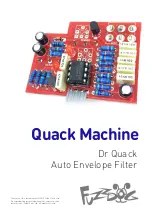
E-DWT-H OPERATION AND MAINTENANCE MANUAL
© 2009 DH Instruments, a Fluke Company
Page 14
The value indicated should be near zero. Press [AutoZ]. This runs AutoZ to
zero the Q-RPT reading (see Section 3.7.10). Upon return to the main run
screen, observe that the indication of measured pressure has zeroed. If the
display fails to zero properly, the RPM4-E-DWT may need repair.
Use [RANGE] to select the Hi Q-RPT (see Section 3.7.2) and repeat the
zeroing process.
If the display fails to zero properly, the RPM4-E-DWT may need repair.
Note
It is normal for RPM4-E-DWT to indicate a value other than zero
when vented when gauge mode is first entered or ranges are
changed, especially if AutoZ is OFF. A value other than zero
may also be indicated if a head correction is being applied (see
Section 3.7.8).
2.4.2
E-DWT Pressure Generation and Control
Perform the RPM4-E-DWT pressure
measurement
operational check (see Section 2.4.1)
before the pressure
generation and control
check.
Refer to Figure 11 and Figure 12 when following this procedure.
Check that there is calibration fluid in the E-DWT-H reservoir and that the E-DWT-H has
been filled and primed with calibration fluid. If the E-DWT-H was delivered for operation
with Sebacate fluid, it was delivered already filled and purged with oil in the reservoir. If
delivered for use with another fluid, fill and purge the E-DWT-H before the pressure
generation and control check following the instructions in Section 5.4.3.
Open the reservoir vent valve by rotating it CCW.
Open the reservoir shut off valve.
Set the variable volume to start position. Rotate variable volume handles CCW until red
of variable volume piston position indicator (top surface of E-DWT-H) is fully retracted.
If the E-DWT-H has dual Q-RPTs, put the Lo Q-RPT shut off valve into the Lo Q-RPT Active
position (rotate valve fully CCW). This opens the Lo and Hi Q-RPTs to the E-DWT-H
pressure generation and control system.
If desired, change the pressure unit of measure using [UNIT] (see Section 3.7.3).
Note
With the Lo Q-RPT connected, never exceed the maximum pressure of the
Lo Q-RPT or it could be permanently damaged. If the red CAUTION
indicator flashes and/or an audible alarm sounds, immediately reduce
pressure to avoid damaging the Q-RPT.
Check that a stainless steel plug is installed in the E-DWT-H top TEST1 and rear TEST2
ports, and that the gland holding the plug is tight.
Slowly lift the reservoir priming pump knob and then push it down at moderate speed with
firm, even pressure. With a brief delay, the pressure indicated by the RPM4-E-DWT
should rise. If the pressure does not rise above 100 kPa (15 psi), it is likely there is air in
the E-DWT-H hydraulic circuit, most likely in the low pressure PFA tubing between the
reservoir and the rest of the system (see Section 5.4.3). It is normal for the pressure to
drop when the reservoir pump is released since the pump is vented by releasing it.
Close the reservoir shut off valve and check that the test shut off valve is open.
Содержание E-DWT-H
Страница 6: ...E DWT H OPERATION AND MAINTENANCE MANUAL 2009 DH Instruments a Fluke Company Page IV Notes...
Страница 10: ...E DWT H OPERATION AND MAINTENANCE MANUAL 2009 DH Instruments a Fluke Company Page VIII Notes...
Страница 82: ...E DWT H OPERATION AND MAINTENANCE MANUAL 2009 DH Instruments a Fluke Company Page 72 Notes...
Страница 120: ...E DWT H OPERATION AND MAINTENANCE MANUAL 2009 DH Instruments a Fluke Company Page 110 Notes...
Страница 122: ...E DWT H OPERATION AND MAINTENANCE MANUAL 2009 DH Instruments a Fluke Company Page 112 Notes...
Страница 124: ...E DWT H OPERATION AND MAINTENANCE MANUAL 2009 DH Instruments a Fluke Company Page 114 Notes...
















































